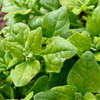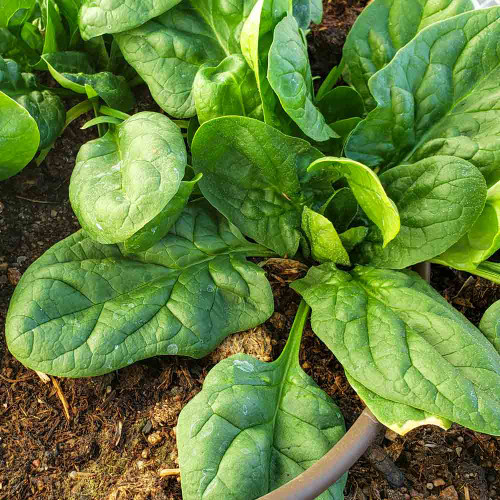Description
New Zealand Spinach
New Zealand spinach is often described as a warm-weather spinach substitute, good for summer salads, as it thrives in hot weather, won’t bolt or get bitter. This ancient native to New Zealand and coastal Australia is not a true spinach but is similar in flavor and use. The young leaves are crisp, juicy, and crunchy like lettuce with a bolder flavor than most lettuces but milder than spinach, while larger ones are closer to spinach in flavor.
Grown in the US as a tender annual, it is a bushy, fast-growing perennial in its native environment with a sprawling habitat that can reach 1-2’ tall and spreads 1-3’ wide. Leaves are triangular and succulent. Will reseed if allowed, makes a great edible border. Very robust, tolerates disease, drought, insects, salt and poor soil.
It is also called tetragonia, ice plant, everbearing spinach, everlasting spinach, perpetual spinach, Maori spinach, Native Australian Bushtucker, Sydney greens, Cook’s Cabbage, Sea Spinach, Tetragon, and Kokihi.
Small yellow flowers start forming in August and later develop into the characteristic four-pointed fruit. The fruit contains the seeds and gives New Zealand spinach its scientific name of Tetragonia, which is derived from Greek and means having four angles.
History
New Zealand spinach was a prevalent food among the Māori people in New Zealand and became famous when European explorers first recorded it in the late 18th century.
When British botanists collected the greens in Botany Bay, Australia, in the 18th century, they were described as having a spinach-like taste, resulting in the spinach moniker, though it is not related to common spinach. The greens were also commonly referred to as Botany Bay greens and Botany Bay spinach.
The abundance of New Zealand spinach in Botany Bay is rumored to have been one of the deciding factors in establishing Australia as a new British outpost. The Transportation Act of 1717 declared that British citizens found guilty of crimes could be sentenced to a British outpost to work and live. Sentences were seven years for non-capital offenses and fourteen years for capital offenses.
In 1783, officer James Matra proposed that Transportation Act prisoners be sent to an outpost on Botany Bay in Australia. Matra had been a part of the first voyage with Captain James Cook to Australia in 1768 and deemed the land fit for a new colony. Botanist Joseph Banks was also on the voyage to Australia and agreed with Matra that the location would be suitable for a new colony.
It is said that Banks stood in front of the House of Commons Committee to discuss the new land, and one of his notable mentions was of a plant similar in flavor and texture to spinach. Banks was referring to New Zealand spinach, and he shared how the green was plentiful throughout Botany Bay and would be an excellent food source for the convicts.
The mention of New Zealand spinach is thought by historians to have helped sway the vote, and by 1787, the first fleet of British convicts was sailed from England to Botany Bay, Australia, arriving in 1788 to build the new colony.
Uses
Young New Zealand spinach has a mild flavor well-suited to raw and lightly cooked dishes. Smaller leaves can be mixed into pesto or chutney, layered into sandwiches, or folded into gnocchi and pasta.
It is sturdier than common spinach and can be used in any recipe calling for spinach. The greens are easily cooked into frittatas, stirred into casseroles, or added to stir-fries. The leaves can also be stuffed into meats, peppers, and squash, cooked and added as a toast topping. Try adding New Zealand spinach to rice, or as an ingredient in spanakopita filling. It pairs well with aromatic herbs like lemongrass, chile peppers, shallots, garlic, and ginger, or vegetables like mushrooms, bell peppers, potatoes, root vegetables, cheeses including feta, parmesan, and cheddar.
Learn More
From the soil to the seed to the food you eat - we'll help you grow your best garden!
1 Review
-
New Zealand Spinach
I grew this plant last year and was amazed by the yield. It grew like a weed (absolutely no help from me!) and tastes like spinach. We used it in salads and sandwiches, as well as a cooked green. Planted it in the early spring and now it is August and the plants are going strong. No bugs, lots of growth, no problem with bitterness. My son goes to the garden and eats it right off the plant.













